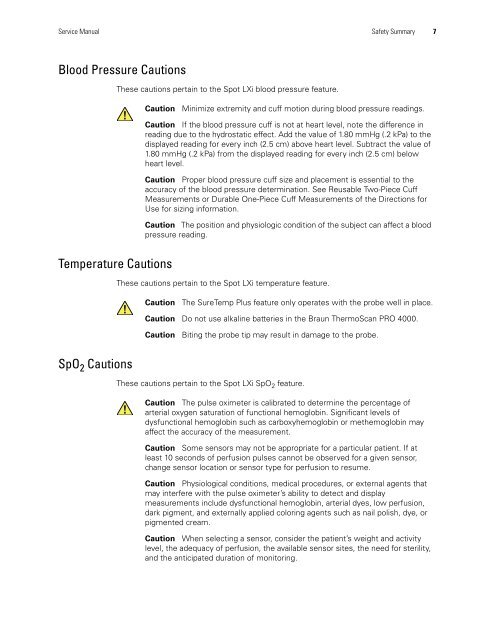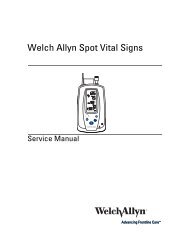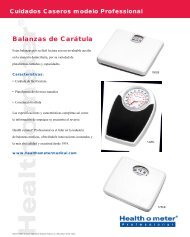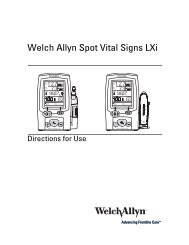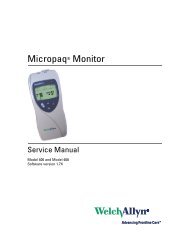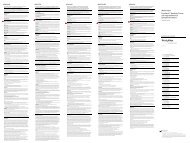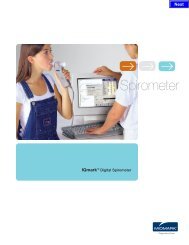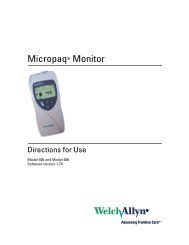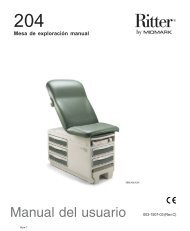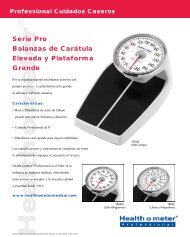Spot Vital Signs LXi Service Manual - Frank's Hospital Workshop
Spot Vital Signs LXi Service Manual - Frank's Hospital Workshop
Spot Vital Signs LXi Service Manual - Frank's Hospital Workshop
Create successful ePaper yourself
Turn your PDF publications into a flip-book with our unique Google optimized e-Paper software.
<strong>Service</strong> <strong>Manual</strong> Safety Summary 7<br />
Blood Pressure Cautions<br />
Temperature Cautions<br />
SpO 2 Cautions<br />
These cautions pertain to the <strong>Spot</strong> <strong>LXi</strong> blood pressure feature.<br />
Caution Minimize extremity and cuff motion during blood pressure readings.<br />
Caution If the blood pressure cuff is not at heart level, note the difference in<br />
reading due to the hydrostatic effect. Add the value of 1.80 mmHg (.2 kPa) to the<br />
displayed reading for every inch (2.5 cm) above heart level. Subtract the value of<br />
1.80 mmHg (.2 kPa) from the displayed reading for every inch (2.5 cm) below<br />
heart level.<br />
Caution Proper blood pressure cuff size and placement is essential to the<br />
accuracy of the blood pressure determination. See Reusable Two-Piece Cuff<br />
Measurements or Durable One-Piece Cuff Measurements of the Directions for<br />
Use for sizing information.<br />
Caution The position and physiologic condition of the subject can affect a blood<br />
pressure reading.<br />
These cautions pertain to the <strong>Spot</strong> <strong>LXi</strong> temperature feature.<br />
Caution The SureTemp Plus feature only operates with the probe well in place.<br />
Caution Do not use alkaline batteries in the Braun ThermoScan PRO 4000.<br />
Caution Biting the probe tip may result in damage to the probe.<br />
These cautions pertain to the <strong>Spot</strong> <strong>LXi</strong> SpO 2 feature.<br />
Caution The pulse oximeter is calibrated to determine the percentage of<br />
arterial oxygen saturation of functional hemoglobin. Significant levels of<br />
dysfunctional hemoglobin such as carboxyhemoglobin or methemoglobin may<br />
affect the accuracy of the measurement.<br />
Caution Some sensors may not be appropriate for a particular patient. If at<br />
least 10 seconds of perfusion pulses cannot be observed for a given sensor,<br />
change sensor location or sensor type for perfusion to resume.<br />
Caution Physiological conditions, medical procedures, or external agents that<br />
may interfere with the pulse oximeter’s ability to detect and display<br />
measurements include dysfunctional hemoglobin, arterial dyes, low perfusion,<br />
dark pigment, and externally applied coloring agents such as nail polish, dye, or<br />
pigmented cream.<br />
Caution When selecting a sensor, consider the patient’s weight and activity<br />
level, the adequacy of perfusion, the available sensor sites, the need for sterility,<br />
and the anticipated duration of monitoring.


